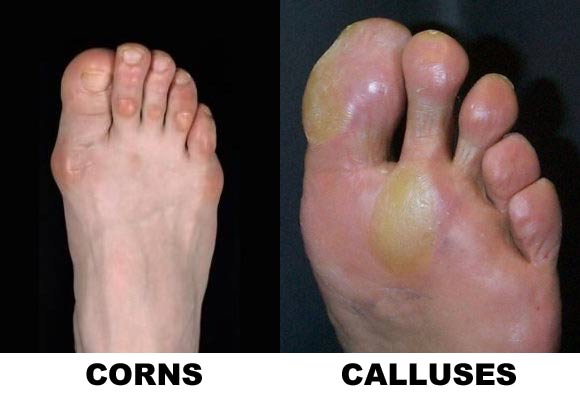
Corns are small, round mounds of firm, dead skin that usually form over bony areas of the toes. Calluses are thickened areas that most often develop on the balls and heels of the feet and on the hands. Both are caused by friction or pressure against the skin, commonly the result of wearing shoes or socks that do not fit properly or engaging in work or sports activities that involve constant rubbing and pressure. In some cases, they are caused by arthritis or deformities in the structure of bones. Hard corns form over bony protuber ances, those between the toes are soft corns. Most corns are yellow, but they may become red when irritated and inflamed. They have a hard, waxy core that forms in the epidermis, or outer layer of the skin, and then bores down into underlying tissue and nerves in the dermis. They cause extreme pain when subjected to pressure. Calluses vary in size and shape. They are generally painless, but some grow so thick that the skin becomes inflexible and cracks, which can cause discomfort. People with diabetes or reduced circulation may develop a potentially serious infection under a callus.
Diagnostic Studies And Procedures
Corns and calluses are easily diagnosed by sight. To pinpoint the cause, a doctor or podiatrist (foot specialist) will ask about routine recreation and work activities and inspect footwear.
Medical Treatments
In most cases, a doctor’s care is not required for these conditions, unless they are severe and persistent or if they become infected and require antibiotics. If they are troublesome, a podiatrist commonly will cut away thickened tissue after injecting a local anesthetic.
Alternative Therapies
Folk remedies abound for treating corns; some are helpful if used in addition to standard self-care methods. Rubbing castor oil on a corn twice a day is recommended as a way to make it gradually peel off. Placing a fresh lemon peel on a corn at night, with the inside of the peel against the corn, is said to make the corn disappear within a few days. A strip of fresh pineapple can be used in the same way. The enzymes and acids in these fruits act on the corn. Taping a moist tea bag on the corn for half an hour every day is also said to remove a corn within a week or two. Poulticing is another popular remedy. One poultice mixture consists of a crumbled piece of bread soaked in ¼ cup of vinegar for half an hour. This is then wrapped in gauze, squeezed to remove excess fluid, taped over the corn, and left in place overnight. Most corns will peel off the next morning, but stubborn ones may require treatment for several nights in succession. Soaking the feet in oatmeal water often helps to ease the pain caused by corns. To prepare the soak, boil 2 cups of finely ground oatmeal with 5 quarts of water until the mixture cooks down to about 4 quarts. Strain it, put it in a large basin, and soak your feet in it for at least 20 minutes.
Self Treatment
The best self treatment for both corns and calluses is to remove the source of the pressure that has been causing them. This means discarding shoes that do not fit properly and padding the callused areas. Nonprescription corn and callus pads reduce pressure. Medications, also available without a prescription, which can order here, soften the skin layers and make them easier to remove, but some can damage skin and should be used with care. You can usually peel a corn by first softening it and then rubbing it with a pumice stone. One way to soften stub born corns is to soak the foot in Epsom salts and water for about 15 minutes and then apply a moisturizing cream. Or cover the corn with a moist gauze pad and wrap the foot in plastic for 15 minutes. Remove the plastic and rub the area with a pumice stone. After peeling, apply a 5 or 10 percent salicylic ointment and cover it with an adhesive bandage. Repeat the treatment daily until the corn disappears. A word of caution: If you have diabetes or any other medical condition that causes poor circulation, do not attempt self-treatment of calluses and corns. Some methods can increase the risk of infections and other complications. Instead, see a doctor or a podiatrist for professional foot care.
Other Causes of Thickened Skin
Plantar warts, virus-caused benign growths that form on the soles, are sometimes confused with calluses. Morton’s neuroma, a growth on a plantar nerve, can cause pressure pain.
References